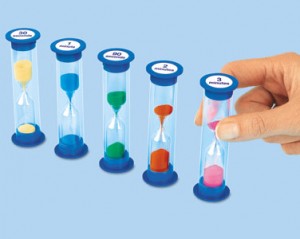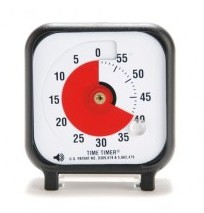
Sand Timers from lakeshore
My first year out of school, I worked with the severely handicapped population. I worked with children aged 5 to 18 with about 3/4 of my caseload being on the autism spectrum. I started researching EVERYTHING I could about working with children of this population. Hours and hours and hours. One of the things I had read about was the use of visual timers in therapy.
The first visual timer I learned about and used regularly was the Time Timer. However…there were some cons to this timer…and then it broke! Then a coworker, a Board Certified Behavior Analyst told me she preferred using sand timers…I decided to buy a few and I never looked back. In fact….it is one of the best tools I use in therapy!
Why use timers?
There are MANY reasons why you might want to start using timers in your sessions. When I first bought my timers, I thought I would only use them with my autism students, however I found that I use them with all my students for various reasons.

Time Timer
- Give little ones a visual representation of how much time is left in an activity or in a session. Time is not something that we can “see” and especially for those who are visual learners, time can be a very hard concept to grasp.
- Giving children a visual “cue” of how long is left in an activity or session can ease anxiety and negative behaviors in relation to the ending of an activity and transitions to the next
- Use timers to help a child know when to start or stop an activity on their own which can help a child gain independence.
- Use timers to keep yourself on task within sessions
When and How I Use Visual Timers
- With children who need instruction in short bursts, followed by short breaks (in a discrete trial sort of way), I use sand timers to show the child how long we will be working for, and how long the “break” will be for. The length of time for each activity varies by the child. Some children start out with only “working” for 30 seconds! Then we slowly build up to longer and longer work times.
- For my small groups, I will use the timers to keep myself on track. When you are working with groups of children, it can sometimes be difficult to give each child an equal amount of attention/interventions. So, I will use the timers to make sure I do this. I typically use my 2 minute timer and work with each child for 2 minutes, and then move around the room. Or, for children who have written work…I may set the timer for 5 minutes and work with one child 1:1 while the other children work on their individual work.
- Articulation Games: For articulation, I love to use my 60 or 90 second timers and have the students try to say as many words with their target sound correctly in that time frame. I will keep track and write down how many they say and if they beat their number from their previous turn, they get a couple M&Ms or jelly beans.
Which Timers to Use?
I personally use the Giant Sand Timers Set and the Classroom Sand Timer Set from Lakeshore Learning.
Want to learn more?
If you want to read more about using timers in therapy sessions, check out these articles:
Visual Timer Handy Handout from Super Super Inc.
How to Use a Visual Timer PDF by Mike Woods, MA BCaBA
Visual Timers at Autism-Tips
Use Visual Timers to Ease Transitions by Adapting Creatively
I agree, time management is such a struggle for many of the children we work with. I personally use an online stopwatch that not only provides a variety of visuals (candle, sand-timer, swimmers etc.) but a sound that alerts everyone when the time has elapsed. Read more about it at: http://www.letstalkspeechlanguage.com/2012/06/resource-of-week.html
Ms.Sohan recently posted..Summer Update
I am also working with a caseload with the majority of kids on the spectrum. I am also trying to RESEARCH, RESEARCH, RESEARCH!!! Any other AU specific suggestions?
There is an online resource called Timerland, http://www.timerland.net , so far there is two timers, a farm timer and a planetary timer. Both are fantastic